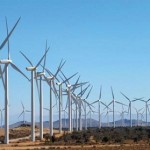On April 26, wind energy major, Suzlon, announced the 12-month test results of its new turbine, which sits atop a 120-m high tower in Kutch, Gujarat, and has blades with a diameter of 111 m–as big as a football field. This 2.1 megawatt turbine generated 7.66 million units of electricity in the past year, or a plant load factor (PLF) of 42%.
This is big for two reasons. Firstly, at 32,000 megawatts of installed capacity, wind energy in India is much bigger than solar and other renewable energy sources. This capacity currently operates at around 20% PLF. Wind turbines at higher altitudes using larger blades can operate at higher efficiencies–as shown by Suzlon’s new one– bringing down the cost of renewable energy. This falling cost is the reason why developers were able to offer electricity at Rs 3.46/unit from 1,000 megawatts of wind capacity in April 2017.
Secondly, the economics of wind versus conventional energy changes at higher efficiency levels. For example, India’s hydropower plants (44,478 megawatt capacity) operated at a total load factor of 31.3% during FY17. Windmills already have a lower capital cost (25-30%) and a much faster execution cycle (1 year versus 5-10 years) compared to hydropower. If they can also generate more electricity, that alters the equation of wind energy versus traditional sources of electricity.
The numbers for wind technology can improve further. It is possible to have even higher capacity utilisation by increasing tower heights and blade diameters and by putting up turbines offshore, where the wind is more consistent. European manufacturers have put up 5-8 megawatt turbines on towers over 200 m height with rotor diameter of up to 150 m. Almost 15,000 megawatts of wind capacity has been constructed globally in the offshore space so far, mostly in Europe.
Gateway House has already described why renewable energy is a better option compared to nuclear power. Renewable energy is now closing in on hydropower as well, which, unlike nuclear power, will have a role to play in the renewable future.
The key shortcoming of renewable energy is that it is intermittent and we don’t have technology to store electricity in bulk. At present, dams are the only way of storing electricity on a large scale. As a result, it is possible to have a grid with renewable energy sources and dams that come to life when the sun goes down or the wind stops.
Waft of diplomacy
Cheaper and more efficient wind energy can also help India in neighbourhood energy diplomacy. China is funding a number of energy projects in India’s neighbourhood–including thermal and nuclear power plants in Pakistan, Bangladesh and Sri Lanka. Sri Lanka has already felt the downside of Chinese ‘investment’ and is now in a debt trap with over $46 billion of external debt. In the case of Nepal, India has signed several agreements to build hydropower plants in the mountainous country. These are long-gestation, capital-intensive projects that are further hampered by the remoteness of the terrain and political unrest. Therefore, India must offer to build wind energy projects in Nepal, Bangladesh and Sri Lanka because:
- their faster execution and modular nature means wind energy projects will show quick and tangible results in Nepal while hydropower can take a decade or more. Successful wind energy projects can pave the way for increased cooperation in larger hydropower projects later.
- Sri Lanka has significant wind energy potential and can sell surplus wind power to India via an undersea cable. Increased electricity trade with India will help balance the Chinese influence.
- wind energy investments in Bangladesh can help avoid billions of dollars of expenditure on nuclear or coal power, which will leave the country in debt.
Renewable energy is going to play a much more prominent role in the future, and within it, wind energy is where Indian companies have the manufacturing and technical knowhow. India can offer its neighbours access to this expertise, preventing them from sinking tens of billions of dollars on overpriced and outdated energy assets.
Amit Bhandari is Fellow, Energy & Environment Studies, Gateway House.
This blog was exclusively written for Gateway House: Indian Council on Global Relations. You can read more exclusive features here.
For interview requests with the author, or for permission to republish, please contact outreach@gatewayhouse.in or 022 22023371.
© Copyright 2017 Gateway House: Indian Council on Global Relations. All rights reserved. Any unauthorized copying or reproduction is strictly prohibited.


